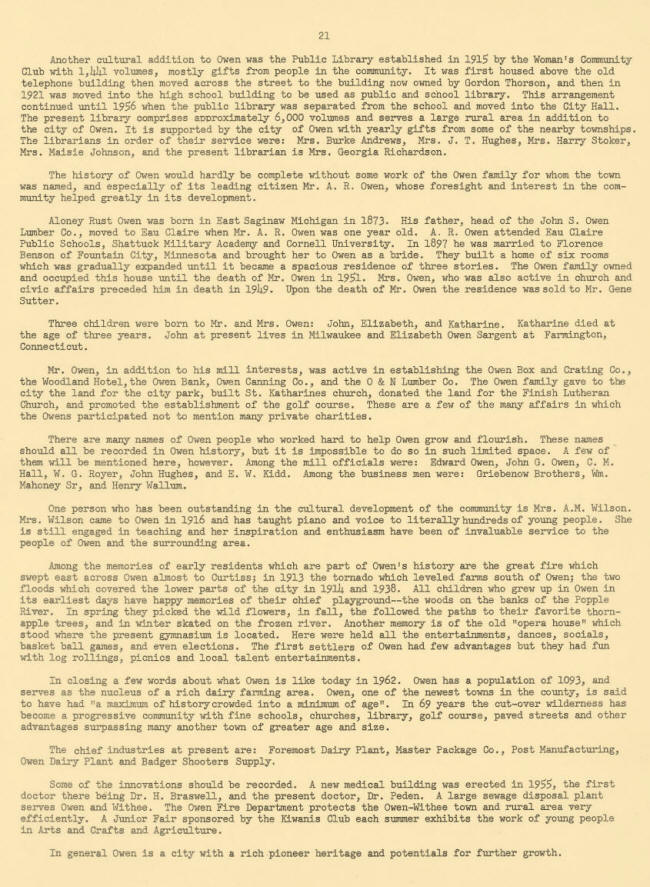|
[Memory
Trails Index]
Transcription
Janet Schwarze
Another cultural
addition to Owen was the Public Library established in 1915 by the Woman’s
Community Club with 1,441 volumes, mostly- gifts from people in the community.
It was first housed above the old telephone building then moved across the
street to the building now owned by Gordon Thorson, and then in 1921 was moved
into the high school building to be used as public and school library. This
arrangement continued until 1956 when the public library was separated from the
school and moved into the City Hall. The present library comprises approximately
6,000 volumes and serves a large rural area in addition to the city of Owen. It
is supported by the city of Owen with yearly gifts from some of the nearby
townships. The librarians in order of their service were: Mrs. Burke Andrews,
Mrs. J. T. Hughes, Mrs. Harry Stoker, Mrs. Maisie Johnson, and the present
librarian is Mrs. Georgia Richardson.
The history of Owen would hardly be complete without some work of the Owen
family for whom the town was named, and especially of its leading citizen Mr. A.
R. Owen, whose foresight and interest in the community helped greatly in its
development.
Aloney Rust Owen was born in East Saginaw Michigan in 1873. His father, head of
the John S. Owen Lumber Co., moved to Eau Claire when Mr. A. R. Owen was one
year old. A. R. Owen attended Eau Claire Public Schools, Shattuck Military
Academy and Cornell University. In 1897 he was married to Florence Benson of
Fountain City, Minnesota and brought her to Owen as a bride. They built a home
of six rooms which was gradually expanded until it became a spacious residence
of three stories. The Owen family owned and occupied this house until the death
of Mr. Owen in 1951. Mrs. Owen, who was also active in church and civic affairs
preceded him in death in l91.9. Upon the death of Mr. Owen the residence was
sold to Mr. Gene Sutter.
Three children were born to Mr. and Mrs. Owen: John, Elizabeth, and Katharine.
Katharine died at the age of three years. John at present lives in Milwaukee and
Elizabeth Owen Sargent at Farmington, Connecticut.
Mr. Owen, in addition to his mill interests, was active in establishing the Owen
Box and Crating Co., the Woodland Hotel, the Owen Bank, Owen Canning Co., and
the 0 & N Lumber Co. The Owen family gave to the city the land for the city
park, built St. Katharmnes church, donated the land for the Finish Lutheran
Church, and promoted the establishment of the golf course. These are a few of
the many affairs in which the Owens participated not to mention many private
charities.
There are many names of Owen people who worked hard to help Owen grow and
flourish. These names should all be recorded in Owen history, but it is
impossible to do so in such limited space. A few of them will be mentioned here,
however. Among the mill officials were: Edward Owen, John G. Owen, C. M. Hall,
W. G. Royer, John Hughes, and E. W. Kidd. Among the business men were: Griebenow
Brothers, Wm. Mahoney Sr, and Henry Wallum.
One person who has been outstanding in the cultural development of the community
is Mrs. A.M. Wilson. Mrs. Wilson came to Owen in 1916 arid has taught piano and
voice to literally hundreds of young people. She is still engaged in teaching
and her inspiration and enthusiasm have been of invaluable service to the people
of Owen arid the surrounding area.
Among the memories of early residents which are part of Owen’s history are the
great fire which swept east across Owen almost to Curtiss; in 1913 the tornado
which leveled farms south of Owen; the two floods which covered the lower parts
of the city in l9llL and 1938. All children who grew up in Owen in its earliest
days have happy memories of their chief playground--the woods on the banks of
the Popple River. In spring they picked the wild flowers, in fall, the followed
the paths to their favorite thorn- apple trees, and in winter skated on the
frozen river. Another memory is of the old “opera house” which stood where the
present gymnasium is located. Here were held all the entertainments, dances,
socials, basket ball games, and even elections. The first settlers of Owen had
few advantages but they had fun with log rollings, picnics and local talent
entertainments.
In closing a few words about what Owen is like today in 1962. Owen has a
population of 1093, and serves as the nucleus of a rich dairy- farming area.
Owen, one of the newest towns in the county, is said to have had “a maximum of
history-crowded into a minimum of age”. In 69 years the cut-over wilderness has
become a progressive community with fine schools, churches, library, golf
course, paved streets and other advantages surpassing many another town of
greater age and size.
The chief industries at present are: Foremost Dairy Plant, Master Package Co.,
Post Manufacturing, Owen Dairy Plant and Badger Shooters Supply.
Some of the innovations should be recorded. A new medical building was erected
in 1955, the first doctor there being Dr. H. Braswell, and the present doctor,
Dr. Peden. A large sewage disposal plant serves Owen and Withee. The Owen Fire
Department protects the Owen-Withee town and rural area very efficiently. A
Junior Fair sponsored by the Kiwanis Club each summer exhibits the work of young
people in Arts and Crafts and Agriculture.
In general Owen is a city with a rich pioneer heritage and potentials for
further growth.
[Memory
Trails Index]
|
